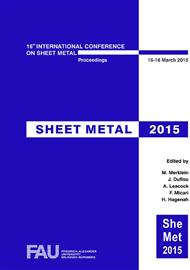[1]
W.Y. Li, A. Vairis, R.M. Ward, Advances in Friction Welding, Advances in Materials Science and Engineering, (2014).
Google Scholar
[2]
A. Vairis, M. Frost, High frequency linear friction welding of a titanium alloy, Wear, 217 (1998) 117-131.
DOI: 10.1016/s0043-1648(98)00145-8
Google Scholar
[3]
A. Vairis, M. Frost, On the extrusion stage of linear friction welding of Ti6Al4V, Materials Science and Engineering a-Structural Materials Properties Microstructure and Processing, 271 (1999) 477-484.
DOI: 10.1016/s0921-5093(99)00449-9
Google Scholar
[4]
W.Y. Li, T.J. Ma, J.L. Li, Numerical simulation of linear friction welding of titanium alloy: Effects of processing parameters, Materials & Design, 31 (2010) 1497-1507.
DOI: 10.1016/j.matdes.2009.08.023
Google Scholar
[5]
A. Vairis, M. Frost, Modelling the linear friction welding of titanium blocks, Materials Science and Engineering a-Structural Materials Properties Microstructure and Processing, 292 (2000) 8-17.
DOI: 10.1016/s0921-5093(00)01036-4
Google Scholar
[6]
M. Aonuma, K. Nakata, Dissimilar metal joining of ZK60 magnesium alloy and titanium by friction stir welding, Materials Science and Engineering: B, 177 (2012) 543-548.
DOI: 10.1016/j.mseb.2011.12.031
Google Scholar
[7]
A. Vairis, Mathematical Modelling of the Linear Friction Welding Process, Journal of Engineering Science and Technology Review, 5 (2012) 25-31.
Google Scholar
[8]
R. Turner, J.C. Gebelin, R.M. Ward, R.C. Reed, Linear friction welding of Ti-6Al-4V: Modelling and validation, Acta Materialia, 59 (2011) 3792-3803.
DOI: 10.1016/j.actamat.2011.02.028
Google Scholar
[9]
W. -Y. Li, T. Ma, J. Li, Numerical simulation of linear friction welding of titanium alloy: Effects of processing parameters, Materials & Design, 31 (2010) 1497-1507.
DOI: 10.1016/j.matdes.2009.08.023
Google Scholar
[10]
W. Li, S. Shi, F. Wang, T. Ma, J. Li, D. Gao, A. Vairis, Heat reflux in flash and its effect on joint temperature history during linear friction welding of steel, International Journal of Thermal Sciences, 67 (2013) 192-199.
DOI: 10.1016/j.ijthermalsci.2012.12.004
Google Scholar
[11]
A.V.Y. a.I.S.N. A.M. Yamileva, Comparison of the Parallelization Efficiency of a Thermo-Structural Problem Simulated in SIMULIA Abaqus and ANSYS Mechanical, Journal of Engineering Science and Technology Review 53(2012) 5.
DOI: 10.25103/jestr.053.8
Google Scholar
[12]
S. Kiselyeva, A. Yamileva, M. Karavaeva, I.S. Nasibullayev, V. Bychkov, А.Y. Medvedev, А. Supov, F. Musin, I. Alexandrov, V. Latysh, Computer modelling of linear friction welding based on the joint microstructure, Journal of Engineering Science and Technology Review, 5 (2012).
DOI: 10.22226/2410-3535-2012-1-40-44
Google Scholar
[13]
A. Ducato, L. Fratini, F. Micari, Prediction of phase transformation of Ti-6Al-4V titanium alloy during hot-forging processes using a numerical model, P I Mech Eng L-J Mat, 228 (2014) 154-159.
DOI: 10.1177/1464420713477344
Google Scholar
[14]
A. Ducato, L. Fratini, F. Micari, Advanced numerical models for the thermo-mechanical-metallurgical analysis in hot forging processes, Aip Conf Proc, 1532 (2013) 3-14.
DOI: 10.1063/1.4806804
Google Scholar
[15]
A. Ducato, L. Fratini, F. Micari, Coupled thermo-mechanical-metallurgical analysis of an hot forging process of titanium alloy, Key Eng Mater, 554-557 (2013) 638-646.
DOI: 10.4028/www.scientific.net/kem.554-557.638
Google Scholar
[16]
A. Astarita, A. Ducato, L. Fratini, V. Paradiso, F. Scherillo, A. Squillace, C. Testani, C. Velotti, Beta Forging of Ti-6Al-4V: microstructure evolution and mechanical properties, Key Eng Mater, 554-557 (2013) 359-371.
DOI: 10.4028/www.scientific.net/kem.554-557.359
Google Scholar
[17]
P.K. Zhao, L. Fu, D.C. Zhong, Numerical simulation of transient temperature and axial deformation during linear friction welding between TC11 and TC17 titanium alloys, Comp Mater Sci, 92 (2014) 325-333.
DOI: 10.1016/j.commatsci.2014.05.062
Google Scholar
[18]
F. Schröder, R. Ward, A. Walpole, R. Turner, M. Attallah, J. Gebelin, R. Reed, Linear friction welding of Ti6Al4V: experiments and modelling, Materials Science and Technology, (2014).
DOI: 10.1179/1743284714y.0000000575
Google Scholar


